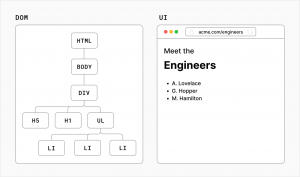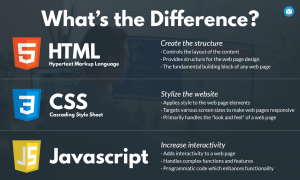 HTML (HyperText Markup Language) adds structure to a web page and its content. JavaScript adds functionality to a web page. CSS is the language to add design elements to the presentation of Web pages, including colors, layout, and fonts. JavaScript is used to make websites and pages more interactive with users, often prompting user-input, connecting webpages to react to button clicks, or processing information and calculating formulas. HTML and CSS are more static, meant to structure or design pages to be visually appealing but not necessarily interactive. While the three are often used together, they can all be used separately as well. CSS is independent of HTML and can be used with any XML-based markup language. JavaScript is often used to develop games and mobile apps and build out graphics.
HTML (HyperText Markup Language) adds structure to a web page and its content. JavaScript adds functionality to a web page. CSS is the language to add design elements to the presentation of Web pages, including colors, layout, and fonts. JavaScript is used to make websites and pages more interactive with users, often prompting user-input, connecting webpages to react to button clicks, or processing information and calculating formulas. HTML and CSS are more static, meant to structure or design pages to be visually appealing but not necessarily interactive. While the three are often used together, they can all be used separately as well. CSS is independent of HTML and can be used with any XML-based markup language. JavaScript is often used to develop games and mobile apps and build out graphics.
JS is an event driven language because it reacts to events. Every time a function is called, it is added to a list; JavaScript then loops through the list and calls the functions connected to each event. If you create a function but do not call it in the main area, JavaScript will not run the function automatically. Everything starts by following an event. 
Leave a Reply
You must be logged in to post a comment.